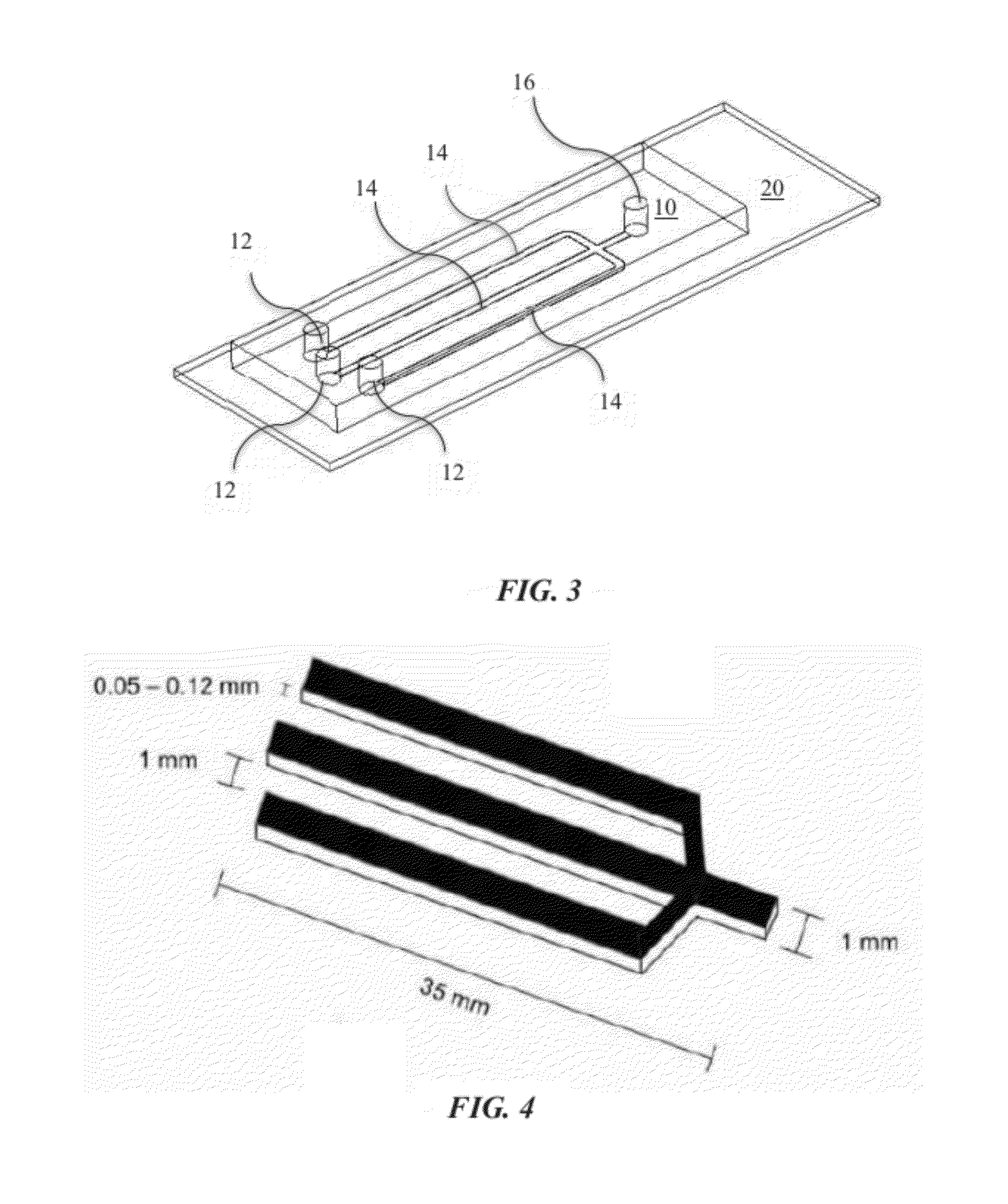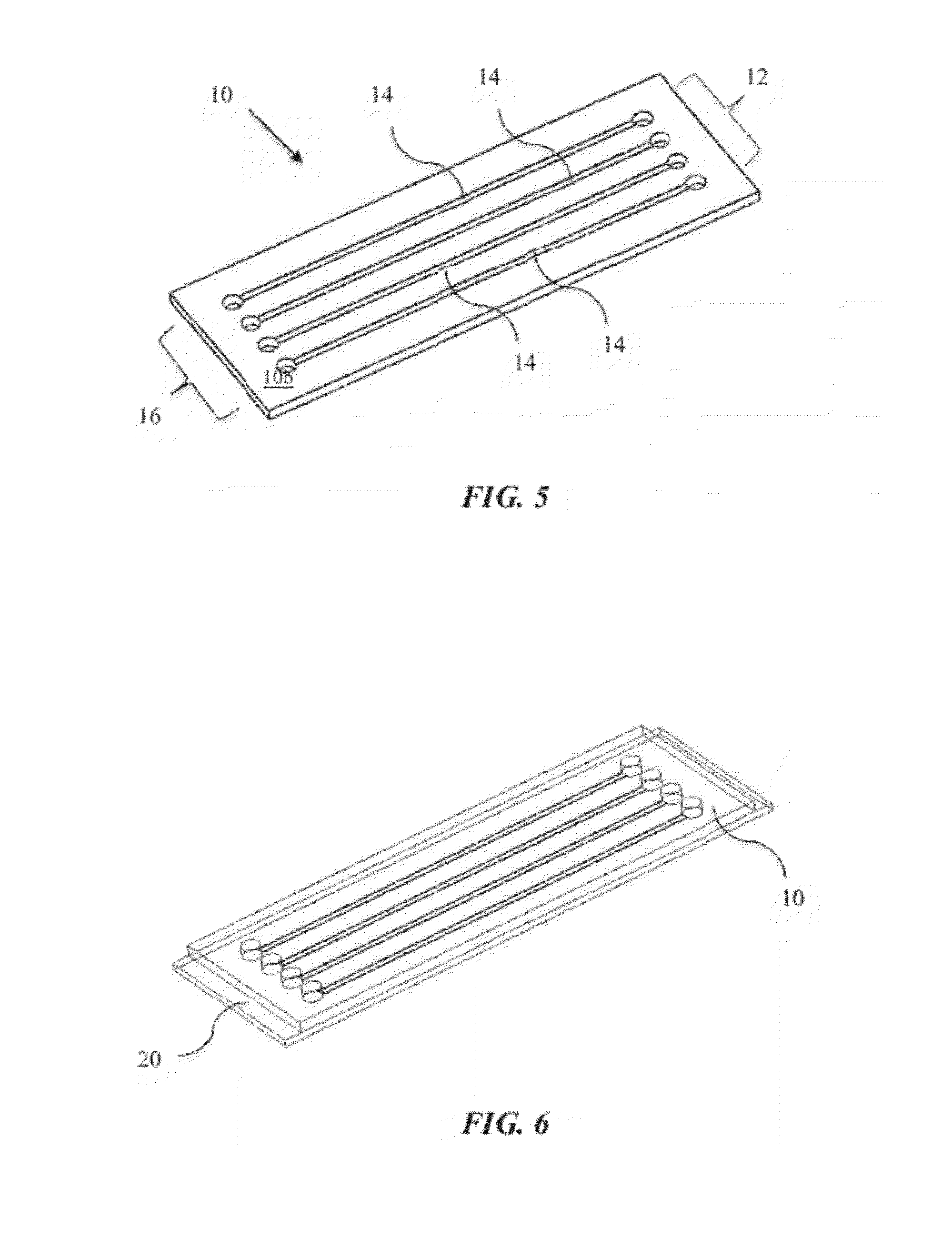Microfluidic Cytochemical Staining System
a microfluidic cytochemical and staining technology, applied in the field of microfluidic tissue analysis, can solve the problems of increasing patient stress, increasing diagnosis time, and restricting the number of stains that can be used in diagnosis, so as to facilitate multiplexed staining of biological samples, enhance the effect of macro-fluidic systems, and improve the accuracy of disease diagnosis
- Summary
- Abstract
- Description
- Claims
- Application Information
AI Technical Summary
Benefits of technology
Problems solved by technology
Method used
Image
Examples
example 1
Materials and Methods
[0074]The following chemicals, biologicals, and supplies were used in the manufacturing and testing of this device: SU-8 3025 photoresist (Micro-Chem. Corp., Newton, Mass.), PDMS (Dow Corning, San Diego, Calif.), Sygard 184 elastomer curing agent (Dow Corning), methanol (Fisher, Pittsburg, Pa.), triton X-100 (Fisher), acetone (Mallinckrodt Chemicals, Phillipsburg, N.J.), isopropyl alcohol (Mallinckrodt), hydrogen peroxide (Mallinckrodt), SuperBlock T20 (PBS) Blocking Buffer (Thermo Scientific, Rockford, Ill.), propylene glycol monomethyl ether acetate (Sigma-Aldrich, St. Louis, Mo.), 4-in. silicon wafers (Silicon Inc., Boise, Id.), IMEB Diff Stain Kit (San Marcos, Calif.), Histochemical Reaction Set—Ferric Iron (EMD Chemicals, Inc., Gibbstown, N.J.), 1×3 inch pre-cleaned glass micro slides (Corning Inc., Corning, N.Y.), 1×3 inch pre-cleaned glass microscope slides (Fisher), 10 mL syringes (Beckton Dickinson, Franklin Lakes, N.J.), 21 ga. 1 inch needles (Beckton ...
example 2
μCC Device Fabrication
[0077]Polydimethylsiloxane (PDMS) μCC overlays were fabricated using SU-8 soft lithography methods published previously. [McDonald, J. C., et al., Electrophoresis, 2000, 21, 27-40; J. C. McDonald and G. M. Whitesides, Acc Chem Res, 2002, 35, 491-499; S. K. Sia and G. M. Whitesides, Electrophoresis, 2003, 24, 3563-3576; Liu, Y., et al., Anal Chem, 2000, 72, 5939-5944; Liu, Y., et al., Anal Chem, 2004, 76, 1513-1517; Liu, Y., et al., Analyst, 2001, 126, 1248-1251]
[0078]Briefly, PDMS molds were prepared on silicon wafers (Silicon Inc.) that were spin coated with SU-8 3025 photoresist (Microchem). The coated silicon wafer was covered with a photomask and exposed to UV light. The silicon wafer was then developed in propylene glycol monomethyl ether acetate (Sigma-Aldrich) leaving behind only [Banham, A. H., et al., Clin Cancer Res, 2005, 11, 1065-1072; Hoeller, S., et al., Histopathology, 2010, 57, 73-80] the desired features on the silicon wafer. Molds were prepare...
example 3
Immunocytochemistry Techniques Using the μCC Device
[0080]Immunocytochemistry (ICC) was carried out on slides based on techniques drawn from previously published methods. [Polak, J. M., and S. Van Noorden, Introduction to immunocytochemistry, BIOS Scientific Publishers, Oxford, 2003; Valli, V., et al., Vet Clin Pathol, 2009, 38, 261-269; Pettigrew, N. M., Arch Pathol Lab Med, 1989, 113, 641-644; Ponce, F., et al., J Vet Diagn Invest, 2003, 15, 330-337] All procedures detailed below were carried out at room temperature.
[0081]In brief, after fixation slides were air dried for at least one hour. After drying, slides were then treated with 0.1% Triton X100 (PBS) (Fisher) for 10 minutes. Slides were rinsed with PBS, then blocked (SuperBlock T20, Thermo Scientific) for 30 minutes. After blotting off of the blocking medium, slides were air dried for 30 minutes before mounting the respective μCC. Once mounted, fluid flow was established by injecting 10 μL PBS into each channel and subsequent...
PUM
 Login to View More
Login to View More Abstract
Description
Claims
Application Information
 Login to View More
Login to View More - R&D
- Intellectual Property
- Life Sciences
- Materials
- Tech Scout
- Unparalleled Data Quality
- Higher Quality Content
- 60% Fewer Hallucinations
Browse by: Latest US Patents, China's latest patents, Technical Efficacy Thesaurus, Application Domain, Technology Topic, Popular Technical Reports.
© 2025 PatSnap. All rights reserved.Legal|Privacy policy|Modern Slavery Act Transparency Statement|Sitemap|About US| Contact US: help@patsnap.com



